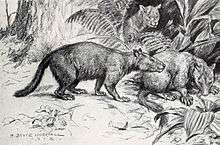Meniscotherium
Meniscotherium is an extinct genus of dog-sized mammal which lived 54–38 million years ago. It was a herbivore and had hoofs. Fossils have been found in Utah, New Mexico. and Colorado. Many individuals have been found together, indicating that it lived in groups.[1]
| Meniscotherium Temporal range: Eocene | |
|---|---|
 | |
| Skeleton | |
| Scientific classification | |
| Kingdom: | |
| Phylum: | |
| Class: | |
| Order: | |
| Family: | |
| Subfamily: | |
| Genus: | Meniscotherium Cope, 1874 |
| Species | |
| |

Restoration of M. chamense
Body mass in M. chamense is estimated to be 5–17 kg, making it about the size of a small dog.[2]
A 2014 cladistic analysis places it within stem perissodactyls.[3]
References
- Thomas E. Williamson and Spencer G. Lucas. 1992. Meniscotherium (Mammalia, "Condylarthra") from the Paleocene-Eocene of western North America. Bulletin, New Mexico Museum of Natural History and Science. Albuquerque. 72 pp.
- Dirks W. · Anemone R. L., Holroyd P. A., Reid D. J. (2009). "Phylogeny, Life History and the Timing of Molar Crown Formation in Two Archaic Ungulates, Meniscotherium and Phenacodus (Mammalia, 'Condylarthra')". Comparative Dental Morphology. Frontiers of Oral Biology. 13: 3–8. doi:10.1159/000242381. ISBN 978-3-8055-9229-1. PMID 19828961.CS1 maint: uses authors parameter (link)
- Cooper, L. N.; Seiffert, E. R.; Clementz, M.; Madar, S. I.; Bajpai, S.; Hussain, S. T.; Thewissen, J. G. M. (2014-10-08). "Anthracobunids from the Middle Eocene of India and Pakistan Are Stem Perissodactyls". PLOS One. 9 (10): e109232. Bibcode:2014PLoSO...9j9232C. doi:10.1371/journal.pone.0109232. PMC 4189980. PMID 25295875.CS1 maint: ref=harv (link)
This article is issued from Wikipedia. The text is licensed under Creative Commons - Attribution - Sharealike. Additional terms may apply for the media files.